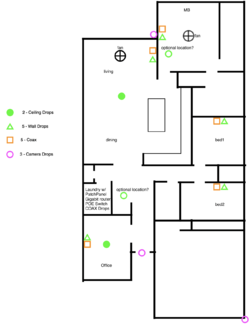- Joined
- Jan 6, 2007
We have a new build we're moving into and were asked if we wanted data drops in the home and we proposed a few but wanted to see if anyone had experience or recommendations to simplify the setup.
The home layout is simple, single story, small floor plan, but open.
The builders have what they call a Homebase unit (where phone/data lines are terminated and direct coax drops from the outside access box are dropped into it as well). The Homebase is a cabinet in a spare closet and about 36" tall and 3-4inch deep. enough for a modem and some other items...but thats there I want to make sure I'm understanding it and setting it up right.
Currently we just have a cable modem + AC Router (Apple) providing network coverage.
The plan is put 2 ethernet drops in the front of the house and 1 in the back - for cameras, have those terminated to the Homebase unit (which if I understand correctly, is essentially like a patch panel), then have 2 additional drops - 1 in the office for hard wiring a workstation or a DVR for the cameras, and one in a nook in the house where the wireless router would be. (central to the home and provides enough coverage).
So in the home base, I'd like know would this work: cable modem, and a switch? the switch will have the patch panel terminations connected via ethernet, and having the wifi-router in the center of the house patched into one wall drop to provide wireless coverage.
Does this sound doable, logical, un-informed, etc? perhaps I'm mis-using switch in place of a router, but would appreciate any clarification.
Appreciate any feedback or critique.
The home layout is simple, single story, small floor plan, but open.
The builders have what they call a Homebase unit (where phone/data lines are terminated and direct coax drops from the outside access box are dropped into it as well). The Homebase is a cabinet in a spare closet and about 36" tall and 3-4inch deep. enough for a modem and some other items...but thats there I want to make sure I'm understanding it and setting it up right.
Currently we just have a cable modem + AC Router (Apple) providing network coverage.
The plan is put 2 ethernet drops in the front of the house and 1 in the back - for cameras, have those terminated to the Homebase unit (which if I understand correctly, is essentially like a patch panel), then have 2 additional drops - 1 in the office for hard wiring a workstation or a DVR for the cameras, and one in a nook in the house where the wireless router would be. (central to the home and provides enough coverage).
So in the home base, I'd like know would this work: cable modem, and a switch? the switch will have the patch panel terminations connected via ethernet, and having the wifi-router in the center of the house patched into one wall drop to provide wireless coverage.
Does this sound doable, logical, un-informed, etc? perhaps I'm mis-using switch in place of a router, but would appreciate any clarification.
Appreciate any feedback or critique.
